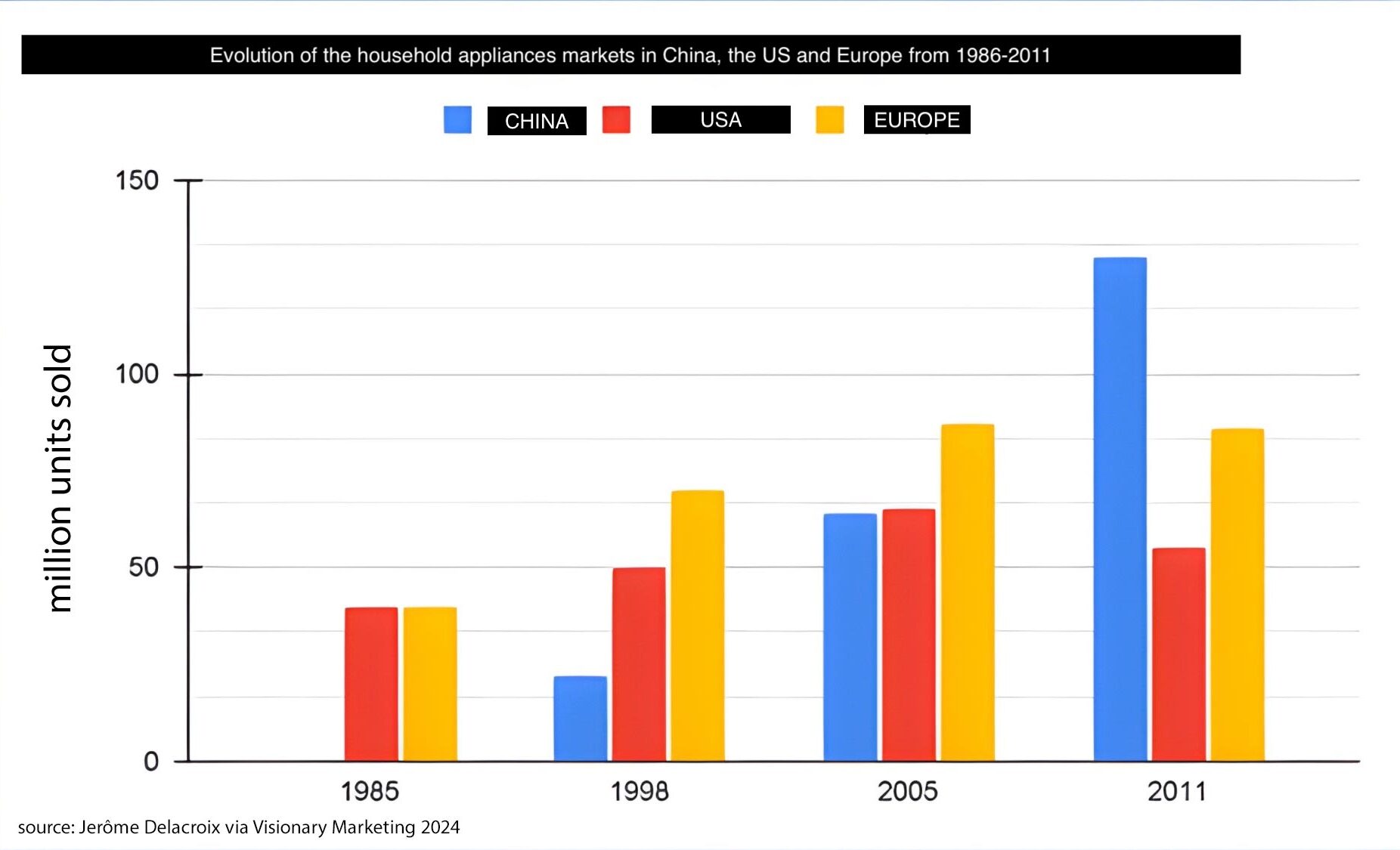Rendanheyi, the Haier Management Model
Is this Chinese management system applicable to Europe?
It’s customary to turn to the US for management lessons, yet Haier, a Chinese company, has probably a lot to teach us too with its Rendanheyi management model. Jérôme Delacroix, a seasoned expert in Chinese management suggests that one could — ironically and provocatively — start copying Chinese companies’ management style. Whatever the case may be, to judge by their success, there are perhaps — all ideological considerations aside — good ideas to take from these oriental companies and Haier in particular. In this interview, Jerome describes the Haier model and its organisational principles for the 21st century.
Rendanheyi, the Haier Management Model

What kind of company is Haier?
Jérôme Delacroix. Haier makes and sell household appliances, yet it isn’t necessarily a household name in Europe. And yet, it has been the world’s number one vendor in that space for the past 14 years. Why did the company choose that name? Because it sounds German. In the 80s and 90s, when it began to modernise, the company chose a model, that of the famous “Deutsche Qualität”, German excellence. And the company’s CEO went to Germany on various study trips. This is what led him to choose a German-sounding name.
A German name and a management model inspired by the US?
JD. What’s fascinating is this Chinese company’s ability to constantly reinvent itself over the last 40 years. And this is probably the key to its success. Indeed, the story begins in 1984 in Qingdao (aka Tsingtao) which is a harbour town in eastern China. It’s where they make beer, in the factory that was set up to cater for the Germans back when the city was bequeathed to them by the Manchus.

Former German Colony and Inspiration From the US
JD. Mr Zhang, like many Chinese managers at the time, had taken over a completely dilapidated factory, the Qingdao Refrigerator Company. This was the period when China was opening up under Deng Xiaoping, a period of reform. So this young boss set about turning the company around.

In fact, Zhang was initially inspired by American theories and in particular by Peter Drucker’s and the emphasis placed on quality. And above all the fact that a company must serve its customers. Which at the time, in China, was anything but obvious.
First Replicate Proven Recipes
JD. For 10 or 15 years, he began applying total quality methods that had proved successful elsewhere, setting up processes and dashboards. These are fairly classic management gimmicks, the aim of which were to get the company back on track.
And it worked rather well, as Haier became the leader in its domestic market. Then, in 1999, with China’s accession to the WTO, the World Trade Organisation, the country really opened up to international competitionMarket definition in B2B and B2C - The very notion of "market" is at the heart of any marketing approach. A market can be defined....
WTO membership meant two things: Western companies could come to China, and Chinese companies were allowed to export outside of China.
Then invent your own Rendanheyi model
JD. That’s when Mr Zhang realised that his model wasn’t going to allow him to scale up. His processes had been fixed and it did the job to an extent. Yet he was convinced at that time that foreign competitors would retaliate and that this model would not allow him to conquer market shareMarket share can be defined as a percentage accounted for by a given producer or brand in its own market. Market share = Current market of producer or brand / Current market of product all brands outside of China.
As a result, at the turn of the 21st century, he was convinced that he had to reinvent his management system. And that’s how, little by little, he was about to invent his own Rendanheyi model through a Sinicisation process, i.e. by bringing in it all the contributions of Chinese culture.

Is Mr Zhang still here today?
JD. He isn’t for he handed over the management of Haier 2-3 years ago. Now, he’s a management guru in China, and delivers inspirational keynotes.
What interests me most, though are the idiosyncrasies of this Rendanheyi management model.
What’s new about it is the desire to give employees a great deal of autonomy. This may seem like deja vu. But that’s not the case.
At Haier, Mr Zhang applied empowerment in a radical way.
Firstly, by breaking it down into what he called micro-units. In other words, each microenterprise could choose its own management method. They had to do that within a given framework, though, a hierarchical framework.
But he did even more than that a little later.

Fully autonomous microenterprises
JD. But from 2005 onwards, and even more so in 2012, he went much further, dividing his company into completely autonomous microenterprises.
And when we talk about autonomy, that means they have their own profit and loss accounts, their own management, the ability to hire and pay employees, and decide which market they’re going to go into.
In this way, he has transformed a company of 50,000 people into a pool of around 4,000 microenterpises with an average of 20 completely autonomous employees.
A video presentation of the Haier Rendanheyi management model by Corporate Rebels
All complete with internal marketplaces, formal contracts and competition between microenterprises. And it worked remarkably well because, as I said, it enabled the company to become the world leader in household appliances.
What’s Ironic Is That Zhang Organised Haier Around Silos
JD. They’re not really silos if what you mean by silo would be separate businesses, next o each other. They do communicate with one another. There is some sort of common understanding between such microenterprises.
Besides, Zhang developed what he called “platforms”. He was a pioneer of platform business models. These are internal marketplaces where each microenterprise offers its services to other microenterprises within the Haier group and to the outside world.
So by everything accessible, the pricing, the offer, and its terms and conditions, the process is entirely transparent.
This organisation is more comparable to a “jungle” than a set of silos.
Hardly any better, a “jungle”, is it?
JD. This is the image Zhang chose. He describes his business as an “old-growth forest”.
The platforms I mentioned earlier are used in lieu of support functions or middle management. The logistics department was replaced with a platform called RRS Logistics, which is in fact a marketplace.
Similarly, with procurement, for which he launched a platform called COSMOplat (an acronym for Cloud of Smart Manufacturing Operation Platform).
It’s the law of supply and demand that governs all these exchanges, with the help of IT that allows you to choose from catalogues, to issue invitations to tender. Exactly as you would with Ali Baba, for example.
What about results and performance?
JD. It’s all about that, precisely. Salaries are linked to performance, that of the microenterprise and also individual performance, according to criteria that are known to all. This culture of excellence is part of the model.
This is what Haier has called the “catfish management“.
Every microbusiness is managed by a leader. The leader is the one who has succeeded in implementing a project and convincing the top management. Please note that the top management is still part of the model. The leader has demonstrated that he is capable of addressing a market, of gathering a team as a leader, etc.
An employee who manages to do this gets a budget, can set up a microenterprise, and then recruit their small team from a talent pool.
Opposite the leader is the catfish. He’s another person, a number 2 you might say. He is known to everyone, and all are aware in advance that he will take the leader’s place if the latter doesn’t achieve his objectives.
It’s false to say that, as far as management techniques are concerned, China never invented anything and just copied others. This doesn’t mean that implementing that model in our businesses would be easily accepted, though.
We Europeans made the same mistake with Taiwan. And the Japanese a few years earlier.
These methods and their results are challenging our own management approaches. There might be a few things we could borrow from this model, even though we wouldn’t be able to implement it as is over here.
So, how can the Haier management style be introduced in Europe?
JD. It’s not necessarily a piece of cake. But this model isn’t necessarily as far removed from our own as you might think at first glance.
Let’s take catfish management as an example. Everyone knows that in large Western organisations, catfish are everywhere. They are deep into politics and aim at eliminating their enemies. Yet, there is no mention of them here, they are working and plotting behind the scenes.
The difference with Haier is that, in their case, internal competition is transparent. And yet it doesn’t mean that there isn’t some form of cooperation.

A management model hard to implement in Europe
JD. Coming back to your point, it’s obviously hard to adapt Rendanheyi as is in European businesses. Besides, labour laws as they stand today probably wouldn’t allow it.
However, some Western businesses are already beginning to experiment in this direction, without going quite so far. They are allowing virtual profit and loss accounts to be managed autonomously, or they add performance-based commissions to their coworkers’ salaries.
Do you know of any examples of Haier’s management model being adopted?
JD. Fujitsu Siemens did. They are not a Europan company, but operates in Southern Europe, particularly in France.
This company has taken inspiration from the Haier Rendanheyi model for its Internet of Things and cloud business. For this venture, it has chosen to implement this highly entrepreneurial model. This is perhaps easier for a spin-off, a new line of business, which aims to address a new market, than for a well-established brand.
“Literally, Rendanheyi is about the close coupling between the value created for users and the value received by employees.
” Ren” means people. Haier uses this term to refer to employees within an organisation. “Dan” here means orders, and represents user needs or demand. “Heyi” means integration. So we’re talking about each employee creating value for the firm’s users. In this model, every employee in every department, including research and development, is responsible for selling – or not selling – the product they help to develop.
Youssouf Chotia & Jérôme Delacroix. “What if we copied Chinese companies?” (French only) Amazon
- Music and AI: Back to the Future - 07/06/2024
- Learning AI with the help of robots - 05/06/2024
- B2B vs. B2C Marketing - 13/05/2024




